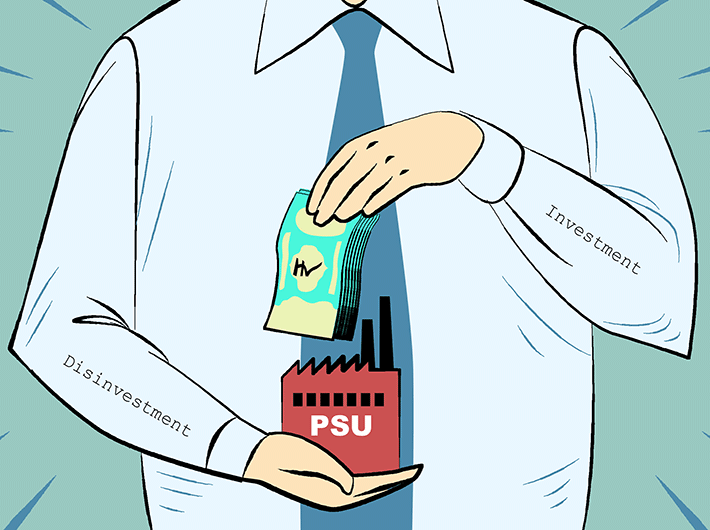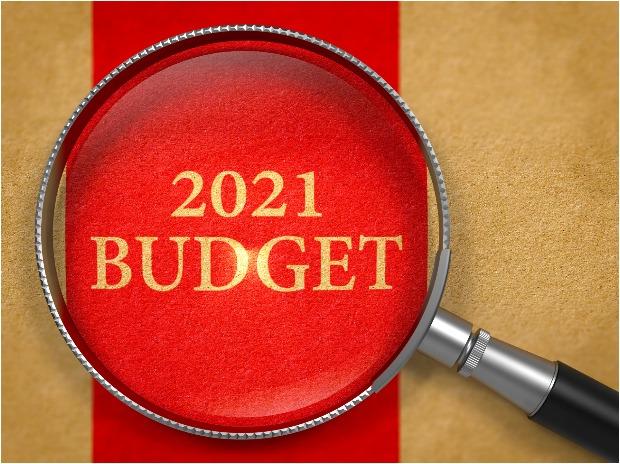The budget silently pushes the power of the Indian public sector into the hands of private players under claims of a fiscal boost. As corporate finances celebrate a win, the expenditures on basic welfare take a backseat in the Union Budget 2021 writes ANIL RAJIMWALE.
——-
FOR the first time in independent India, there is a full-scale power-shift from the public sector to the financial private sector. The trend has been observably rising in the financial sector since 2016. Though Corona has knocked out the economy, the financial business has shown signs of improvement. While productive capitalists, Micro, Small and Medium Enterprises (MSMEs), workers, peasants, business persons and industrialists, have lost heavily, a handful of corporate businesses have seen growth.
Public Sector Undertakings (PSUs) show trends of forced integration with disinvestments undertaken in all sectors for the first time. In a dramatic break from the past, the government has announced the privatisation of at least two state-run banks and a general insurance company with Rs 1.75 lakh crore sale target fixed for 2022.
The Union Budget 2021 claims a ‘massive fiscal boost’ which ideally translates into a massive boost to finance capital. The fiscal deficit in terms of GDP has gone up from the budget estimate (BE) of 2020-21 from 3.5 percent to a soaring 9.5 percent as mentioned in the revised estimate (RE).
It is claimed that the budget seeks to boost growth. However, its questionable policies and schemes state otherwise. The policies make it clear that private finance capital and monopoly capitalist corporations are massively converting productive capital into finance capital with the help of state governments. Large sums of money are being poured in to fatten financialisation of capital.
The government has embarked upon ‘strategic sales’ of several public sector enterprises such as Bharat Petroleum Corporation Limited (BPCL), Competition Commission of India (CCI), Shipping Corporation and Industrial Development Bank (IDBI) to name a few. These enterprises are currently in the pipeline of disappearance indicating a systematic dismantling of PSUs despite profits.
The policies make it clear that private finance capital and monopoly capitalist corporations are massively converting productive capital into finance capital with the help of state governments. Large sums of money are being poured in to fatten financialisation of capital.
Finance Minister, Nirmala Sitharaman had rhetorically questioned the use of allocating money that fails to perform. However, it also hides the fact that successful performers, both private and public are being destroyed.
The LIC Act
The government has paved the way for ‘Initial Public Offering’ or IPO of the country’s largest investor and insurer, the state-run LIC (Life Insurance Company). LIC Act will be amended and rules under the Companies Act will be framed for LIC.
The government holds a 95 percent stake in LIC, which has assets worth more than 34 trillion rupees. After the IPO, the government will hold 75 percent of the stake for five years, which will then be reduced to 51 percent.
LIC is a hugely profitable public sector establishment. It recorded new business premiums worth Rs 1.3 trillion from April to December 2020, which is double the amount collected by all private life insurance companies put together. Therefore, the actions taken by the government in the case of LIC has garnered much criticism.
The government responded to these observations with claims that the Foreign Direct Investment (FDI) hike will boost the insurance sector. However, the reality is quite different from what is constructed.



Private insurers will grow fast and expand their presence in India. Greater capital infusion by big foreign monopoly financial insurers will transfer control to cash-rich foreign monopolies. This will raise stiff competition to LIC which currently commands 70 percent of the Indian insurance market. This presents the real face of the government’s ‘Atmanirbharat’ (self-reliance) and ‘nationalism’.
Staggered Disinvestment Approach of the Government
The budget saw the government declare disinvestment policies for Air India and Pawan Hans in 2020-21. Air India is currently in debt due to deliberate government policies. A ‘special purpose vehicle’ or SPV was set up in 2018 to financially ‘restructure’ it which is simply another word for dismantling it. This SPV is Air India Asset Holding Company, which has been allocated Rs 2,268 crores only to disinvest AI. This move puts profit-making LIC and loss-generating Air India on the same level.
The budget comes with a flag bearing financial domination and the stock markets have responded jubilantly to it.
The Hindustan Petroleum Corporation Limited (HPCL) has been on the receiving end of the government’s financial assault since 2016.
The dismantling of HPCL gave the government huge funds – Rs 46,378 crore in 2016-17, Rs 100,642 crore in 2017-18, Rs 85,063 crore in 2018-19, Rs 49,828 crore in 2019-20 and 18,223 crore in 2020-21.
Stock Market’s Response to the Budget
Stock markets, the finance hub of the country, had wildly cheered the announcements of dismantling. Bank Nifty galloped to a whopping 8.26 percent, Nifty soared to 647 points and Sensex was up by 2315 points in a day. The budget comes with a flag bearing financial domination and the stock markets have responded jubilantly to it.
The Finance Minister has claimed that investment and asset monetisation are the government’s priorities. However, while giving ample description of monetisation, she failed to point out investments in productive areas, which is what the country badly needs today.
The Union Government has talked of huge capital expenditure which includes an increase of Rs 5.54 lakh crore. This, in fact, is an expenditure of capital without productive returns. The National Monetisation Pipeline, a vehicle for conversion of state and people’s capital into financial money, is working overtime. Under its cover, anything can be monetised for the corporate sector.
The Finance Minister has claimed that investment and asset monetisation are the government’s priorities. However, while giving ample description of monetisation, she failed to point out investments in productive areas, which is what the country badly needs today.
The expression ‘bad bank’ is being given a presentable face. The banking sector’s problem of existing bad loans is sought to be solved, not by forcing the big business to return them, but by setting up of unheard ‘bad banks’. A respectable name in ‘asset management’ or a reconstruction company will take over the ‘stressed assets’ to dispose them to interested investors. This is allegedly yet another way to help the finance capital. Not only this, banks are to get an equity infusion of Rs 20,000 crore this year to shore up their capital base. In other words, there will be an intervention on behalf of the finance capital.
The government has also proposed alternate investment funds or Alternative Investment Funds (AIFs) to buy bad loans. It is supposed to take place for the purpose of ‘value realisation’, as the finance minister put it, or for the realisation of profits for the finance capital, to put it clearly.
Gross Non-profit Assets (NPAs) of banks could rise to 14.8 percent by September 2021. Therefore they are reluctant to take up the valuation hence the job will be shifted to the financial sector.
The number of ‘dollar millionaires’ was 50 in 2003, while in 2019 their number increased to 263. Agri share in employment was 62.6 percent in 1991, falling to 42.4 percent in 2019. Its share in gross value added was 27.3 percent in 1991 and 16 percent in 2019.
A 15 per cent agri-infrastructure and development cess has been levied on crude palm oil, crude soybean and crude sunflower oil. This will increase the cost of soaps, biscuits and certain other packaged items. The cess has been levied on peas (40 percent), chickpea (30 percent) and lentils (20 percent). According to the category chief of Parle Biscuits, edible oils form 30 percent of the total cost of producing cheap biscuits and thus will increase its prices substantially.



The Prime Minister has claimed that the budget reflects a vision of self-reliance. However, based on facts, the idea of ‘self-reliance’ translates into a few overlooked facts. While FDI flow in 1991 was 129 million dollars, it grew 576 times by 2020-21 to a staggering 74,390 million dollars. Foreign portfolio investment which was a mere 4 million dollars in 1991, stood at 30, 542 million dollars on 31 January 2021 despite the COVID-19 pandemic. The FDI limit in the insurance sector would be raised from 49 percent to 74 percent, with Indians effectively losing all control over the sector.
The Price Paid by the Education Sector
While gates have been opened for massive growth of corporate finance, expenditures on basic welfare measures have been reduced. The government has cut down on education spending by Rs 6000 crore, and schools have taken the biggest hit.
The education budget has been slashed by six percent from Rs 99,311 crore in 2020-21 to Rs 93,224 crore, the lowest in three years. School education has lost Rs 5000 crore and higher education, Rs 1000 crore. No announcement has been made regarding losses to children incurred during the pandemic.
Rural Employment Overlooked
The National Rural Employment Generation Scheme (NREGS), which emerged as a safety net for many migrants returning during the lockdown, did not find any mention in the Finance Minister’s speech. Allocation for it has been reduced by 34 percent in the budget estimate (BE) compared to that in the revised estimates (RE). Over seven crore households relied on NREGS in the last year, which marks an all-time high. Amidst an unprecedented demand for unskilled labour in the current financial year, the allocation for NREGS has been slashed.
Oxfam reports India’s top 100 billionaires had their wealth surge by 35 percent during the Corona epidemic alone. This amount can give 13.8 crores of poorest Indians a check for Rs 94, 045. The top ten percent now own half of India’s wealth, while the bottom 50 percent hold only 14.7 percent.
One in seven lost their jobs during the pandemic, yet Mukesh Ambani’s RIL made Rs 90 crore per hour the same period. Around 1,70,000 people lost their jobs in April 2020 alone. Yet India has been ranked 7th in market capitalisation in the world. While stocks are firing up and top tier businessmen are flourishing amidst the budget announcement, rapid financialization of capital is emerging as a serious threat to the Indian economy. (IPA Service)
(Anil Rajimwale is an author of numerous books. The views are personal)


